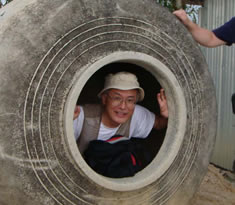Cutting-Edge Research
in Kyoto University
PALEONTOL
Searching for Primate Fossils in Southeast Asia Evolutionary history and differences of primate fauna in Southeast Asia.

fossils in Myanmar

by Dr. Takai and his colleagues

province of Thailand
Since 1998, I have carried out paleontological investigations in central Myanmar with the main aim of discovering primate fossils. Myanmar is located in continental Asia, and since the 19th century it has been very well known for producing a diverse quantity of mammalian fossils, including those of primates from the Tertiary sediment (up until sixty five million years ago). In particular, fossil primates from the latest Middle Eocene Pondaung Formation are regarded as the oldest anthropoid primates in Southeast Asia (including New and Old World monkeys, apes, and humans). I am now searching for primate fossils from the Late Miocene to Pliocene Irrawaddy sediments in Myanmar to make comparisons with the Pleistocene primate fauna in Guangxi Province, southern China. The differences in primate fauna are likely influenced by the environmental change in Southeast Asia, such as the emergence of a monsoon climate.

- Masanaru Takai, PhD
- Professor, Primate Research Institute
